|
20 August 2006
Niue, The Rock, S 19.03 W 165.55
The Smallest Self Governing State in the World
On clear nights in the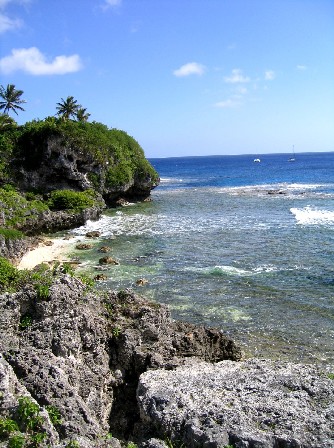 Pacific we are in awe of a bright twinkling star that sets in the eastern sky. We view it most often while underway and even with the naked eye it is an impressive spectacle but when viewed through the binoculars you can see that the star literally flashes red. green, and white. We weren't the only cruisers to notice the uniqueness of this star. It so happened that our friends Randy and Sheri on Procyon were having a group for sundowners on their boat when the topic of the star came up and Randy and Sheri knew exactly which star we were talking about. Now if anyone should know about stars it would be Randy and Sheri. Their boat name is after all Procyon which is the eighth brightest star helping make up the constellation, Canis Minor. The star we were seeing is Canopus, the second brightest star viewable from earth but viewable only south of Norfolk, Virginia and evidently the further south the better the view. You might ask what is the brightest star and that would be Sirius but it is much closer to the earth. And another thing..............I really must stop this. I have recently completed reading Bill Brysons' book A Short History of Nearly Everything and have become an insufferable "know-it-all". Many people have described me as such before I read the book and finally I am in agreement. I just can't help telling Rene some mundane little points of knowledge from the book which I would highly recommend. Take for instance...... Pacific we are in awe of a bright twinkling star that sets in the eastern sky. We view it most often while underway and even with the naked eye it is an impressive spectacle but when viewed through the binoculars you can see that the star literally flashes red. green, and white. We weren't the only cruisers to notice the uniqueness of this star. It so happened that our friends Randy and Sheri on Procyon were having a group for sundowners on their boat when the topic of the star came up and Randy and Sheri knew exactly which star we were talking about. Now if anyone should know about stars it would be Randy and Sheri. Their boat name is after all Procyon which is the eighth brightest star helping make up the constellation, Canis Minor. The star we were seeing is Canopus, the second brightest star viewable from earth but viewable only south of Norfolk, Virginia and evidently the further south the better the view. You might ask what is the brightest star and that would be Sirius but it is much closer to the earth. And another thing..............I really must stop this. I have recently completed reading Bill Brysons' book A Short History of Nearly Everything and have become an insufferable "know-it-all". Many people have described me as such before I read the book and finally I am in agreement. I just can't help telling Rene some mundane little points of knowledge from the book which I would highly recommend. Take for instance......
Fishing during our recent passage from Bora Bora to Niue again proved the point that you really can't fish from a sailboat while under sail. You are either going too slow or too fast, meaning the lure is not traveling fast enough to attract pelagic fish or if you hook one you are going too fast to land it. The first day out we slugged our way through two converging lows and it rained most of the day. The wind shifts kept us busy tacking and jibing and adjusting sails in winds from 5-39 knots. Even with all this going and the attendant rain we had our lines in the water. The number of wind direction changes invariably led to a line getting caught in the running gear resulting in the loss of a lure and a great deal of line. With this said, however, we landed three good size yellow fin tunas and lost a very large mahi mahi that jumped out of the water three times and on the last leap spit the lure back at us. We were using a red skirted lure about 6 inches long.
On the second day we used a home made lure from Rene's workshop and landed a dolphin 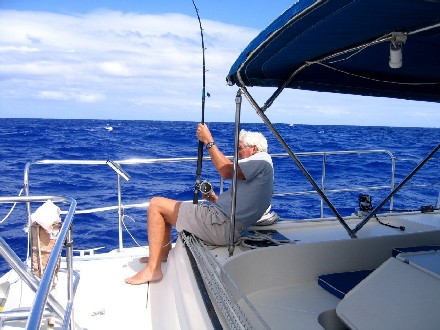 early in the day. The winds were stabilizing and the easterly trade winds were picking up. We were starting to make good boat speed. At this more optimal speed our lure was more attractive and we had a strike from what we believe was one of the largest fish we had ever hooked. The fight was on and it was all you could do to hold the pole erect let alone gain any purchase on the fish by reeling. Little by little we did make progress and I say we because the fight was too tiring for one person. Part of the problem was the wind picked up just as we hooked the fish and now we have a large fish pulling to get away from the boat and the boat moving forward at about 7 knots, most of the time a winning combination only for the fish. We tried to slow the boat down with only a small degree of success. We mistakenly felt that we could land the fish without reversing direction. We could see a large silvery and yellowish flash in the water as we finally worked the fish closer to the boat but at last the line snapped at the tip of the rod. II staggered back and dropped the rod so I could catch my balance. Fortunately we tie each pole to the boat. Our biceps ached from the strain and we were greatly disappointed about losing this particular fish. Rene got another grocery bag and quickly made another lure. Yep, plastic bags make the best skirts. We haven't found that the fish have a preference for bags from a particular store but we were using white plastic bags with a few stripes made with a magic marker. Twice more that day we hooked a dolphinfish and after a considerable fight lost both of them. We finally landed one later in the day. This was more action than we have seen since we have been in the Pacific but it was not to end here. The very next morning we landed another dolphinfish. early in the day. The winds were stabilizing and the easterly trade winds were picking up. We were starting to make good boat speed. At this more optimal speed our lure was more attractive and we had a strike from what we believe was one of the largest fish we had ever hooked. The fight was on and it was all you could do to hold the pole erect let alone gain any purchase on the fish by reeling. Little by little we did make progress and I say we because the fight was too tiring for one person. Part of the problem was the wind picked up just as we hooked the fish and now we have a large fish pulling to get away from the boat and the boat moving forward at about 7 knots, most of the time a winning combination only for the fish. We tried to slow the boat down with only a small degree of success. We mistakenly felt that we could land the fish without reversing direction. We could see a large silvery and yellowish flash in the water as we finally worked the fish closer to the boat but at last the line snapped at the tip of the rod. II staggered back and dropped the rod so I could catch my balance. Fortunately we tie each pole to the boat. Our biceps ached from the strain and we were greatly disappointed about losing this particular fish. Rene got another grocery bag and quickly made another lure. Yep, plastic bags make the best skirts. We haven't found that the fish have a preference for bags from a particular store but we were using white plastic bags with a few stripes made with a magic marker. Twice more that day we hooked a dolphinfish and after a considerable fight lost both of them. We finally landed one later in the day. This was more action than we have seen since we have been in the Pacific but it was not to end here. The very next morning we landed another dolphinfish.
The fourth day we had no strikes. The fish disappeared just as the winds disappeared. Either the lures were not moving fast enough to attract pelagic fish or we were too far from any point of land. On the fifth day we landed another dolphin and the freezer was starting to look like we could make it to Australia without buying meat.
The foll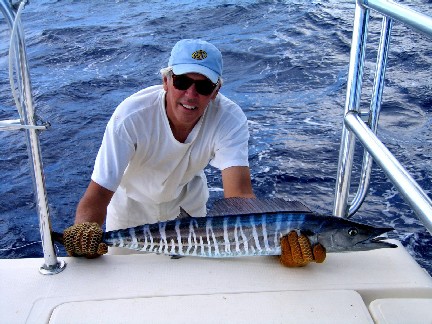 owing day we took a break because the winds were so high but then the seas had calmed a bit and we put a blue homemade lure out. All day long we waited and listened for the shrill of the fishing line leaving the reel, but nothing. The next day we went back to white and soon enough we were reeling in a nice size Wahoo. While we were landing this fish we noticed that there were three Rainbow Runners under the boat. Our Pacific fish identification book (a present from our friends on Camperdown) aptly describes these fish as impossible to catch with a lure. We dangled everything we had in front of them but no bites. Finally I took the primitive approach and speared one with our hand spear while standing on the transom steps in lumpy seas going about 6 knots. I wouldn't recommend this approach but after several tries it was a hit! I was able to flip the twenty pound fish on board. This was not a fish that was worn out from a long fight. It was ready to wrestle. Rene passed me the knife to perform a lobotomy. Just as I finished the job and pulled the spear from the fish it thrashed vigorously and made its way overboard. owing day we took a break because the winds were so high but then the seas had calmed a bit and we put a blue homemade lure out. All day long we waited and listened for the shrill of the fishing line leaving the reel, but nothing. The next day we went back to white and soon enough we were reeling in a nice size Wahoo. While we were landing this fish we noticed that there were three Rainbow Runners under the boat. Our Pacific fish identification book (a present from our friends on Camperdown) aptly describes these fish as impossible to catch with a lure. We dangled everything we had in front of them but no bites. Finally I took the primitive approach and speared one with our hand spear while standing on the transom steps in lumpy seas going about 6 knots. I wouldn't recommend this approach but after several tries it was a hit! I was able to flip the twenty pound fish on board. This was not a fish that was worn out from a long fight. It was ready to wrestle. Rene passed me the knife to perform a lobotomy. Just as I finished the job and pulled the spear from the fish it thrashed vigorously and made its way overboard.
Well this must sound like the golfer who replays every stroke after the round while sitting in the clubhouse drinking a beer. I know there is nothing more boring than to listen to that but ten days at sea with little to do but read books and look at the stars, fishing is what breaks the monotony. Well there is dental flossing.
So now, nine days after leaving Bora Bora, we find ourselves in Niue and are happy about how things turned out. Niue was on our agenda after Atutaki in the Southern Cook Islands but the winds weren't favorable for the rhumb line to Atutaki so the decision was made to go with the flow and continue heading west to Niue. In the cruising guides you might find information about the Niue Yacht Club. This is an active organization that is very helpful to visiting yachts and maintains about 11 mooring balls in the bay off the town of Alofi. A mooring ball cost $10.00 per day NZD. The club house evaporated during the cyclone last year but there is still a cinder block building with showers and potable water. When approaching the island, call in to Niue Radio for an appointment with customs and for clearance to pick up a mooring ball. You will probably need to pick up the customs agent at the dock. The dock facility is limited and you must hoist your dinghy out of the water ever time you come in. The first time it is a three man job but after you get the hang of it two people can land the dingy and launch it again without a problem.
Keith, the commodore of the Niue Yacht Club visited our boat and gave us many interesting stories about Niue and even offered to give us an Island tour. However the next day a forceful front came in and the winds clocked around and were coming from the west and we were unable to approach the dock due to the swells and strong winds. Oh yeah, and at the same time the island was havin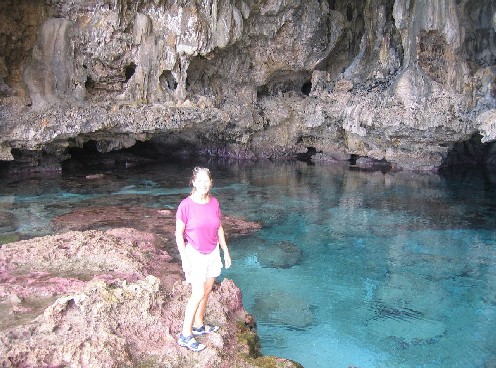 g severe power outages so the club was concerned that if we pulled our dinghies out of the water then we might not be able to get it back in. It was touch and go with the power for a couple of days. Anyway, back to the story. Well, two days after Keith had left the island, we rented a van and with fourteen others took off on a self guided tour of the island. Niue may offer some of the most interesting geological formations of any island we have visited. Our first stop was to the tidal pools of Limu where a few fish and sea snakes live in saltwater tidal pools which are also fed by underground fresh water rivers creating a most unusual visual distortion. For some reason, all fine edges are blurred by the phenomena and it is as if you have the wrong prescription lenses on. We haven't the scientific explanation yet but are contacting our daughter, Kim, who can hopefully provide us with the answer. The water is warm and cold within a span of ten feet. Access to the site is easy and in fact the entire island is well marked. g severe power outages so the club was concerned that if we pulled our dinghies out of the water then we might not be able to get it back in. It was touch and go with the power for a couple of days. Anyway, back to the story. Well, two days after Keith had left the island, we rented a van and with fourteen others took off on a self guided tour of the island. Niue may offer some of the most interesting geological formations of any island we have visited. Our first stop was to the tidal pools of Limu where a few fish and sea snakes live in saltwater tidal pools which are also fed by underground fresh water rivers creating a most unusual visual distortion. For some reason, all fine edges are blurred by the phenomena and it is as if you have the wrong prescription lenses on. We haven't the scientific explanation yet but are contacting our daughter, Kim, who can hopefully provide us with the answer. The water is warm and cold within a span of ten feet. Access to the site is easy and in fact the entire island is well marked.
Next we stopped at the Talava Arches where limestone arches reach four stories or more above the sea level. An information sign said that the walk from the road would take 15 to 30 minutes but don't believe this underestimation. Be sure to wear hard soled shoes as the island is made up of sharp limestone and coral and the walk is very uneven. Our party made it in reef walkers and sandals but hard bottom shoes would have been much more comfortable.
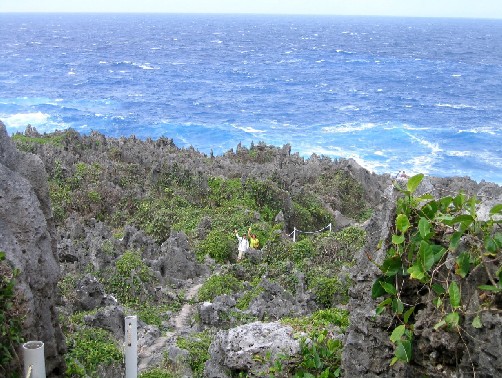
Our last tour stop was at Tago Chasm on the windward side of the island. The day we visited the waves were crashing onto the limestone peaks creating spumes of 40-50-60 feet or more. After a 20 minute hike through the forest you come upon topography that reminds you of a science fiction novel. A path has been sculpted through the forest, through the limestone pinnacles, to the shore and to a sandy beach inside a hole forty foot deep hole. After we climbed down the enormous ladder and were preserving this Kodak moment, sea water showered over the outer wall from a breaking wave. We were all baffled as to how a wave could reach at least fifty feet into the air and a good 30 feet back from the shore line to spray us. The violence of the sea on that day was formidable. In fact, several boats that arrived during this period of bad weather declared that it was the worst weather they had ever encountered in all their years of sailing. We were talking to people who have sailed for 13 years or more. In the next few days several more boats limped into the harbour and anchored nearby since all the mooring balls were now taken. We were fortunate and thankful that we had arrived before the weather turned bad. As we all stood at the top of the cliff looking down into the chasm, the sea cave, and the dramatic coastline we could understand why Captain Cook dubbed Niue "the Savage Island" when he attempted to come to shore in 1774. Actually the name came from the inhospitable natives who would not let him land on the island.
We finished the tour at the Pacific Side Bar. The bar is oriented toward dart competition and there was a women's match underway when we arrived. This gave us the opportunity to meet a few more locals which was always a pleasurable and interesting encounter.
Niue has turned out to be a very pleasant surprise. Everyone we have met has been very friendly and helpful and there is a realization by the Niueans that tourism is the only industry of consequence. Reef Fisheries has a processing plant on the island and there is limited agriculture, vanilla beans mostly. Today there are two flights a week. Most tourists visit to dive in the clearest water in the South Pacific and to see the seas snakes. The humpback whales visit the water during this season and we have seen them spouting just off the stern of our boat.
And if you get a chance don't miss the Wash-Away-Bar on Wednesday 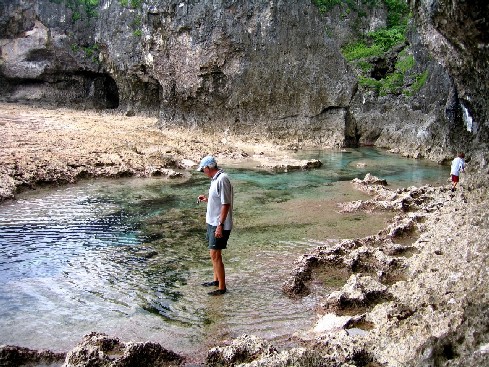 nights. Most of the cruisers in the anchorage drop in on Wednesday because of the live band. We asked the gentleman who was telling us about the place if the band was good and he said "They're live". Well that's good enough for us. When we arrived the power was off but the drinks were still cold so we all sat down to enjoy an incredible sunset. A little later the owner showed up with a generator in the back of a pick up truck and soon after that we had live music from the "Raw Fish Band" and were served hamburgers, fresh seafood, or steaks. What a great time. nights. Most of the cruisers in the anchorage drop in on Wednesday because of the live band. We asked the gentleman who was telling us about the place if the band was good and he said "They're live". Well that's good enough for us. When we arrived the power was off but the drinks were still cold so we all sat down to enjoy an incredible sunset. A little later the owner showed up with a generator in the back of a pick up truck and soon after that we had live music from the "Raw Fish Band" and were served hamburgers, fresh seafood, or steaks. What a great time.
For another nice evening visit the Matavai Resort. It is quite nice with a lovely view of the waves crashing in to shore. We went early for the Happy Hour and the sunset and stayed for the "fish and chip" special that they have on Friday nights. And can you believe that Niue has a 9 hole golf course. Several of the yachties played golf on Sunday afternoon (they are one of the few places open on Sunday but not until after 3:00 when the last church service ends) and the club picked thirty of us up at the docks and took us to the club house for an evening of pool, darts, and good food. Even the local ice cream man opened his shop for anyone that wanted dessert afterwards.
It is really hard to let go of this mooring ball and continue on our journey. Niue is such a special place and a lot of our friends are just now arriving. But onward we must go so that we can be in Australia by the end of October and the start of cyclone season. But for now Niue we must bid you farewell and will leave with wonderful memories of special friends. Thanks for going out of your way to make us welcome on your special island.
For more images of Nuie.......click on the arrow to start the slide show and the square to stop the show. Enjoy!
If you're headed that way:
- Weather information is not readily available so if you are going it is important that you be able to down load Gribb files and Fiji NADI Fleet codes on you SSB. Usually some conscience cruiser will down load the weather faxes from NZ and gives a radio net interpretation. You will need a small softwear program to interpret the Nadi Codes but just ask anyone in the anchorage and you are sure to find a copy.
- Everything in Niue is a bargain after shopping in French Polynesia but still overpriced as compared to Panama. Duty free liquor is available in Niue but it is not cheap.
- Two books that give a historic and contemporary view of the South Pacific might be of interest to people traveling this way. Blue Latitudes by Tony Horwitz and The Happy Isles of Oceania by Paul Theroux have been entertaining and informative.
- A fixed based ham operator conducts a net on SSB frequency 8173 each morning at 8:00 local time providing good weather information. The "ragg of the air " is the handle.
- You can apply for your Australian visa on-line. We suggest you do this well in advance especially if you want an extended stay. We were required to have chest X-rays because we had spent more that 3 months in a developing nation. and also required to submit financial information due to the length of stay.
Back Next
|